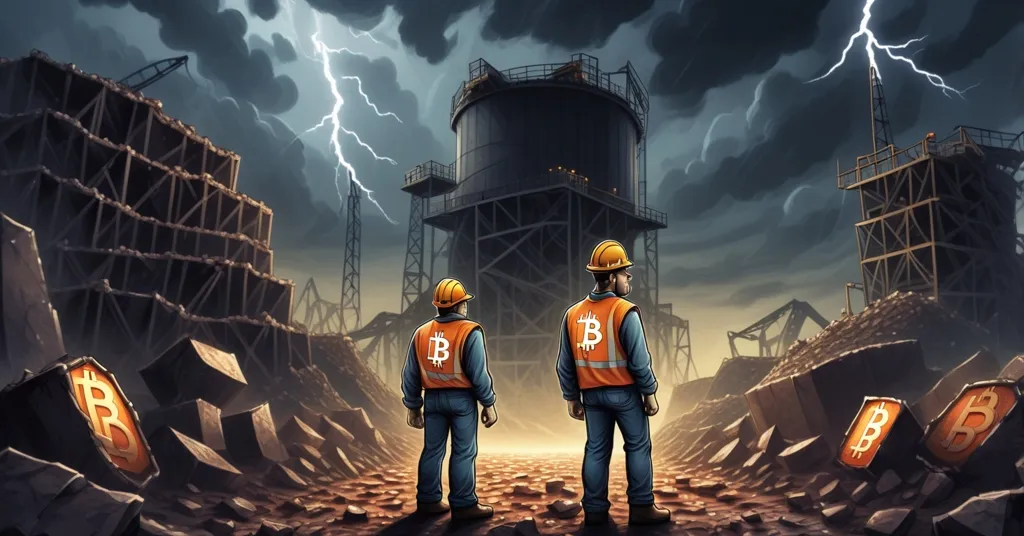Bitcoin Mining Crisis: Paper BTC, Centralization, and Energy Politics Threaten Core Principles

Block Reward Mining in Crisis: Paper Bitcoin, Centralization, and Energy Politics Shake Bitcoin’s Foundation
Bitcoin mining, the engine powering the world’s premier decentralized currency, faces a perfect storm of economic, technical, and political threats that could undermine its very foundation. As miners grapple with collapsing revenues, concentrated power, and restricted access to cheap energy, the core promises of security and decentralization hang in the balance—while scams like HashFlare expose the predatory underbelly of the crypto space.
- Paper Bitcoin Drain: Idle BTC in ETFs and treasuries cripples transaction fees, starving miners.
- Centralization Risks: Major pools control over 50% of hashrate, threatening Bitcoin’s decentralized ethos.
- Energy and Policy Clashes: Political blocks on renewables squeeze U.S. miners amidst soaring demand.
Bitcoin’s strength lies in its miners—those unsung heroes who validate transactions and secure the blockchain by solving complex mathematical puzzles, earning block rewards and transaction fees in return. But when the economics of mining falter, so does the network’s resilience. Let’s unpack the layers of this crisis, from hoarded “Paper Bitcoin” to centralized power grabs, energy roadblocks, and the persistent shadow of fraud. Buckle up; this isn’t just a glitch—it’s an existential test for the hardest money we’ve got.
The Paper Bitcoin Problem: Starving Miners of Revenue
Imagine a vault stuffed with gold that never circulates in the economy—it’s valuable, sure, but it doesn’t fuel the daily grind of commerce. That’s essentially “Paper Bitcoin,” a term describing the massive amounts of BTC—potentially up to 2 million coins, with spot ETFs alone holding around 1.3 million as of August 2025—sitting idle in the hands of treasury firms and exchange-traded funds. According to a recent Galaxy Digital report on Paper Bitcoin’s impact, this hoarding has gutted on-chain activity, with transaction fees dropping a staggering 80% since the April 2024 Bitcoin halving, which slashed block rewards to 3.125 BTC per block. Miners, desperate for income, have accepted a 90% reduction in minimum transaction fees, with 15% of new blocks being practically “free” (fees below 1 satoshi per virtual byte, a measure of transaction cost). Worse, nearly half of blocks aren’t even full due to a stagnant mempool—the pool of unconfirmed transactions awaiting processing.
“A fee market in retreat raises real questions regarding network security … If more BTC volume continues to migrate to ETFs, custodians, and fast alt-L1s, the core network risks becoming a settlement layer without sufficient settlement activity.” – Galaxy Digital Report
This isn’t just a numbers game; it’s a security issue. Bitcoin’s design assumes fees will eventually replace diminishing block rewards to incentivize miners to keep the network safe. If fees don’t recover—and speculative activity keeps shifting to faster, cheaper blockchains like Solana for memecoins and NFTs—Bitcoin could become a ghost town of settlement with too little action to sustain itself. Galaxy Digital’s warning is stark: without a robust fee market, the long-term economics of Bitcoin security are shaky at best. But let’s play devil’s advocate for a moment—could this hoarding by ETFs stabilize Bitcoin’s price volatility over time, even if it screws miners short-term? It’s a trade-off worth chewing on, though I’d argue network health trumps speculative price games any day. For more community perspectives, check out discussions on Paper Bitcoin’s impact.
Centralization: A Ticking Time Bomb for Decentralization?
Bitcoin was born to defy central control, yet mining power is consolidating faster than a Wall Street merger. On August 19, 2025, Foundry USA (33.6%) and AntPool (17.9%) together commanded over 51% of the network’s hashrate—the total computational muscle securing Bitcoin. For the uninitiated, a 51% attack means a single entity or coalition could theoretically rewrite the blockchain, double-spend coins, or censor transactions. While data from MiTrade on Foundry and AntPool’s hashrate dominance points out that such an attack is unlikely due to individual miners within these pools being decentralized and the economic cost of collusion being astronomical, the situation still looks like a damn disaster for Bitcoin’s ethos. Five pools now control nearly 80% of global hashrate, a far cry from the garage rigs of Bitcoin’s early days.
History offers a sliver of hope—back in 2014, GHash.io hit 51% and faced fierce community backlash, with miners voluntarily diversifying to smaller pools. Social pressure worked then, but today’s industrial-scale mining, fueled by giants like Bitmain (who also self-mine in cheap power regions), makes decentralization a tougher fight. A counterpoint emerges: maybe centralization isn’t an immediate death knell if pools lack incentive to attack. After all, tanking Bitcoin’s trust would tank their profits. Still, relying on “trust us, we won’t” from mega-pools feels like playing Russian roulette with decentralization. Community initiatives like Stratum V2, a protocol update giving miners more control over block construction to reduce pool dominance, show promise—but adoption is slow. If mining keeps consolidating, we might as well call it “Bankcoin” and hand the keys to Wall Street. For a deeper dive into the mechanics, explore the Bitcoin protocol details.
Energy Politics: Powering Bitcoin or Powerless Miners?
What happens when the electricity Bitcoin miners depend on becomes a political football? Mining profitability is razor-thin, with over half of revenue swallowed by power costs, as highlighted in a detailed analysis of the mining revenue crisis. TeraWulf’s CFO Patrick Fleury put it bluntly: mining is a brutal business. The U.S., home to 75% of global hashrate, faces a 3% surge in energy demand for 2025, intensified by competition from AI data centers. Miners like CleanSpark are pivoting hard, with CEO Matt Schultz admitting they’re more focused on monetizing megawatts than chasing hashrate. But access to cheap, sustainable energy is getting hammered by policy decisions.
“We no longer talk about hashrate, only about how to monetize megawatts.” – Matt Schultz, CEO of CleanSpark
The Trump administration recently slapped a stop-work order on the Revolution Wind Project—80% complete and slated to power 350,000 homes—through the Bureau of Ocean Energy Management. Trump doubled down on Truth Social, declaring, “Will not approve wind or farmer destroying Solar.” For an industry leaning on renewables to slash costs, this is a sucker punch. Miners aren’t just crunching numbers; they’re dodging political landmines. Yet, some are adapting—TeraWulf is exploring nuclear-powered mining, and off-grid solutions are gaining traction. Globally, places like Kazakhstan lure miners with energy surpluses, while China’s underground mining creeps back post-ban. The U.S. dominance isn’t guaranteed if policy keeps choking renewables. Bitcoin’s energy hunger clashes with real-world politics, proving decentralization doesn’t shield you from government whims. For more on this dynamic, see insights on energy politics and Bitcoin mining.
Scams in the Shadows: HashFlare’s $577 Million Sting
While miners battle economics, the crypto space’s dark side preys on desperation. Enter HashFlare, a fraudulent mining operation run by Estonian nationals Sergei Potapenko and Ivan Turõgin, who scammed investors out of $577 million between 2015 and 2019. Promising big returns, they operated just 164 rigs while claiming 80,000, flashing fake dashboards to dupe hundreds of thousands. Acting U.S. Attorney Teal Luthy Miller didn’t hold back, calling it “a classic Ponzi scheme.” After forfeiting $450 million in assets—luxury cars, real estate, jewelry—they got a laughable “time served” sentence, $25,000 fines each, and 360 hours of community service. The U.S. Department of Justice is appealing, pushing for 10-year prison terms to make an example, as detailed in updates on the HashFlare fraud case. Cloud mining scams are the snake oil of crypto—don’t buy the hype unless you’ve seen the hardware with your own eyes.
“HashFlare [was] a classic Ponzi scheme … [with] hundreds of thousands of victims.” – Teal Luthy Miller, Acting U.S. Attorney
This isn’t a one-off; it echoes BitConnect’s collapse, reminding us that crypto’s trustless promise is often weaponized by grifters. As miners struggle, scams exploit the hungry and uninformed. Regulatory hammers need to hit harder—slaps on the wrist won’t deter the next con. For investors, skepticism isn’t optional; it’s survival. The broader impact of such frauds is explored in discussions on HashFlare’s effect on crypto trust.
Adaptation or Collapse: Miners Fight Back with Diversification
Not everyone is waving the white flag. Hut 8, a heavyweight in mining and energy infrastructure, is charging ahead with plans to develop four new U.S. sites, adding 1.5GW of capacity to hit over 2.5GW for Bitcoin mining and high-performance computing (HPC). With $2.4 billion in liquidity, CEO Asher Genoot is laser-focused on high-demand energy markets, stating the goal is to “broaden our geographic footprint.” This pivot beyond pure mining—tapping into broader energy monetization and HPC—shows grit. Even with eyebrow-raising ties to Donald Trump’s sons via their subsidiary American Bitcoin Corp, Hut 8’s strategy mirrors a wider trend. Firms like Riot Platforms and Marathon Digital are also diversifying, though risks loom—overexposure to non-crypto markets could backfire if energy plays flop. Still, adaptation beats stagnation, and Hut 8 is betting big on outlasting the storm.
Emerging Threats: Quantum Risks and Blockspace Debates
Beyond immediate crises, quieter threats loom. Over 1.5 million BTC sit in legacy P2PK addresses—old wallet formats with exposed public keys vulnerable to future quantum computers, which could crack encryption far faster than today’s tech. Another 6 million BTC in slightly newer P2PKH formats aren’t much safer. Quantum tech isn’t here yet, but experts peg viable risks within a decade. If you’re holding BTC in outdated wallets, migrate to modern standards like P2WPKH now—don’t wait for a quantum thief to empty your stash. For further reading on related challenges, see this analysis of Paper Bitcoin and centralization threats to mining.
Then there’s the Bitcoin Core v30 release on the horizon, stirring debate over larger OP_RETURN outputs—data fields in transactions often used for embedding messages or metadata. Critics argue this could bloat blockspace with spam, further pressuring fees, while supporters see it as free expression on the blockchain. It’s a niche fight, but with miners already squeezed, any added strain on blockspace matters. These issues pale compared to Paper Bitcoin or centralization, but they’re sparks that could ignite bigger fires if ignored.
Key Takeaways and Questions
- Is Paper Bitcoin truly crippling miner revenue?
Yes, Galaxy Digital reports an 80% fee drop since the April 2024 halving, driven by 1.3-2 million BTC sitting idle in ETFs and treasuries, slashing transaction volume and miner income. - Does mining centralization endanger Bitcoin’s security?
It’s a concern, not a certainty—Foundry and AntPool’s 51% hashrate control poses a theoretical risk of attacks, but individual miner decentralization and economic disincentives reduce the likelihood. - How are political decisions impacting mining sustainability?
The Trump administration’s block on renewables like Revolution Wind restricts cheap energy for U.S. miners (75% of global hashrate), clashing with rising demand from AI and crypto operations. - What lessons emerge from the HashFlare fraud?
The $577 million scam underscores crypto’s vulnerability to exploitation—trustless systems are only as strong as your due diligence; fake mining ops prey on blind faith. - Can miners like Hut 8 survive these challenges?
Potentially, through diversification—Hut 8’s 1.5GW expansion into HPC and energy infrastructure, backed by $2.4 billion in liquidity, charts a path beyond pure Bitcoin mining.
Bitcoin remains the pinnacle of decentralized money, and as a maximalist, I believe in its unmatched soundness as the hardest asset humanity’s crafted. But blind faith won’t cut it—these cracks in mining economics, centralization, and energy access are real. Altcoins like Solana fill niches Bitcoin shouldn’t chase, handling fast, cheap speculative plays while BTC stays the bedrock. Yet, ignoring these threats isn’t effective accelerationism; it’s gambling with freedom and privacy. Miners can adapt, as Hut 8 proves, and the community has rallied before—think smaller pools, better protocols like Stratum V2, and wallet security upgrades. Scammers must face harsher reckoning, and we must stay vigilant. Disrupting the status quo means staring down the ugly truths and forging ahead anyway. Bitcoin’s future is ours to build, but only if we fight for it.



